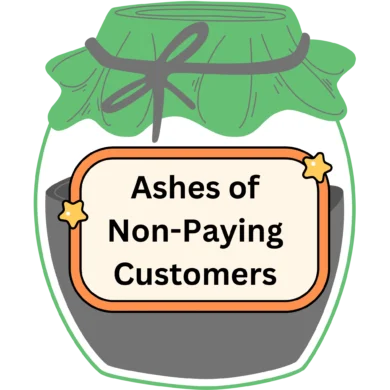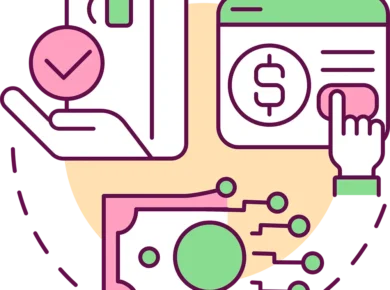As freelancing continues to increase in popularity, many individuals enjoy the perks of independence, flexible work schedule, and the freedom to work from anywhere. Yet, this freelance utopia can sometimes hit a snag—non-payment or delayed payment from clients.
As a freelancer, you likely have encountered this disheartening situation. When it happens, not only does it jeopardize your financial stability, but it can also leave you feeling powerless and undervalued. In this comprehensive post, we will explore proactive measures to ensure that, as a freelancer, you’re not left high and dry regarding your hard-earned compensation.
The Heavy Cost of Non-Payment and Delayed-Payment
Immediate Financial Impact
The immediate financial hit from non-payment can be substantial. This becomes an even bigger issue if you outsource part of the project, as you will be responsible for paying for those services without receiving any income for the project. This could leave you scrambling to cover bills and living expenses, turning what was a successful business venture into a personal crisis.
Undermining Client Trust
Non-payment incidents can erode your trust in your clients, possibly damaging valuable long-term relationships. Maintaining a solid client-freelancer bond is crucial for reoccurring work and positive recommendations.
Time and Opportunity Loss
Beyond the immediate financial impact, not receiving payment for a project also translates to lost time and missed opportunities to engage in other work. In a profession where time directly equates to income, these intangible losses carry substantial weight.
Cash Flow Challenges
When payments are postponed, it interrupts your expected cash flow, leading to challenges in covering operational costs or personal financial obligations.
Decline in Productivity and Morale
The uncertainty of when you will be paid can negatively affect your productivity and morale, dampening your spirits and disrupting the creative and professional flow essential to freelancing success.
Heightened Business Risks
Consistent payment delays can jeopardize your business’s financial stability, potentially forcing you to take on debt or forgo essential business expenditures to maintain operations.
Strategies for Preventing Payment Issues
To safeguard against the risk of not being paid by clients, you can implement several strategies that fortify your financial security.
Establish Clear Payment Terms and Contracts
Begin by drafting contracts with explicit payment terms. This foundational step secures a mutual understanding between you and your client regarding the payment timeline and amounts. A clear contract acts as your first line of defense, providing legal backing should disputes arise over payment. For example, before starting a new project, draft a contract that outlines the scope of work and deadlines and specifies payment amounts and due dates. Make sure to include:
- Payment Milestones: Define specific milestones throughout the project for which payment is due. For instance, 30% upfront is paid upon contract signing, 30% after the first draft is approved, and the remaining 40% upon project completion.
- Late Payment Fees: Incorporate a clause that details the consequences of late payments, such as a 2% monthly late fee on overdue amounts, to encourage timely payment.
- Cancellation Policy: Include terms that address cancellation by either party. For instance, if the client cancels the project halfway through, they are still responsible for payment of all work completed up to that point. Or at least they forfeit the amount paid upfront.
- Revision Policy: Clearly state how many revisions you include and the costs of the additional revision. This prevents scope creep and ensures you are compensated for any extra work.
An example contract clause might read: “Payment is due in three installments: 30% ($1,500) upon contract signing, 30% ($1,500) upon delivery of the first draft, and the remaining 40% ($2,000) within 14 days of project completion. Late payments will incur a fee of 2% of the overdue amount per month.”
By specifying these terms, both you and your client have a clear understanding of the financial obligations from the outset, reducing the likelihood of disputes and ensuring that you are paid fairly and on time for your work.
For freelancers seeking legal assistance in drafting contracts, several resources are available to ensure the agreements are comprehensive, clear, and legally binding. Here are a few places where you can find legal help for contract creation:
- Legal Websites: Platforms like LegalZoom, Rocket Lawyer, and Nolo offer various legal services and templates, including contract drafting. These websites provide customizable contract templates that you can tailor to your specific needs.
- Freelancer Platforms: Many freelancer platforms, such as Upwork and Freelancer, offer contract templates and advice tailored to the needs of freelancers. These resources are designed to protect both the freelancer and the client throughout the project.
- Local Bar Associations: Many local bar associations offer referral services to attorneys specializing in contract law or have experience working with freelancers. Some associations might also provide free legal clinics or consultations for small businesses and independent contractors.
- Online Legal Services: Companies like Avvo allow freelancers to ask legal questions online, where experienced attorneys can offer advice. Additionally, these platforms can connect freelancers with lawyers for more in-depth consultation or contract drafting services.
- Legal Aid Organizations: If you have a limited budget, legal aid organizations may offer free or low-cost legal services, including contract drafting and review. These services are typically available based on income eligibility.
- Professional Networks: Engaging with professional networks and industry groups can also lead to legal resources. Networking with other freelancers might provide you with referrals to trusted attorneys who understand the nuances of freelance contracts.
By utilizing these resources, you can obtain the legal assistance needed to create solid contracts that protect your interests and provide a clear framework for your professional relationships.
Enhance Transparency with Detailed Task Lists
Enhancing transparency through detailed task lists is a pivotal strategy for freelancers aiming to build trust and clarity with their clients. This approach involves meticulously documenting every task you perform during a project and the time spent on each task and presenting this information as part of your invoicing process.
For example, instead of simply billing for “10 hours of graphic design work,” break down those hours into specific tasks, such as “2 hours: Conceptualization and brainstorming,” “3 hours: Drafting initial designs,” “4 hours: Revisions based on client feedback,” and “1 hour: Final adjustments and delivery.” Attach this detailed list to your invoice. This level of detail accomplishes several important objectives:
- Demonstrates Value: It allows clients to see exactly what they are paying for, highlighting the meticulous effort and expertise that went into each stage of the project. This detailed breakdown helps justify your rates by linking them directly to the value and complexity of the work performed.
- Promotes Transparency: Detailed task lists foster an atmosphere of openness and accountability. Clients are more likely to trust and feel satisfied with your services when they can clearly see how their investment translates into tangible work products.
- Facilitates Clear Communication: Providing a breakdown of tasks can also serve as a basis for discussions about the project scope, priorities, and any adjustments needed in future projects. It opens the door for constructive feedback and collaborative planning, ensuring that both parties are aligned on expectations and outcomes.
- Prevents Disputes: When you attach a detailed Billable List, such as those generated by PlanArty, to your invoices, it minimizes the likelihood of disputes over charges. Clients have a clear record of the work done, which they can reference in case of any questions or concerns about the invoice.
- Streamlines Record-Keeping: For both you and your client, having a detailed account of work performed makes record-keeping more straightforward. This can be particularly beneficial for long-term projects or when working with multiple freelancers, as it provides a clear and organized overview of project progress and expenses.
Incorporating detailed task lists into your invoicing process is more than just a best practice for billing; it’s a cornerstone of professional freelancing that enhances client relationships, supports fair compensation, and underpins successful project management.
Utilize Payment Protection Platforms
Utilizing payment protection platforms is a strategic move for freelancers seeking to secure their financial transactions and minimize the risk of non-payment. These platforms function as intermediaries, holding funds in escrow until both you and your client are satisfied with the completed work. This system ensures that payment is already secured before you start working, significantly reducing the likelihood of disputes and non-payment scenarios.
Practical Examples
- Escrow Services: Escrow.com is a prime example of a payment protection service that holds payment from the client in an escrow account until the project deliverables are approved. For instance, if you’re a freelance web developer, the client would deposit the project fees into Escrow.com at the start of the project. Only after you complete the website and the client approves the work will Escrow.com release the funds to you.
- Freelance Platforms: Many freelance platforms like Upwork and Freelancer have built-in payment protection systems. When you take on a project through Upwork, the client’s funds are placed into an escrow account. As you reach agreed-upon milestones or complete the project, the funds are released to you. This ensures that you’re guaranteed to be paid for every hour you log or project milestone you complete.
- Digital Contracts with Integrated Payment: Platforms like Bonsai and AND.CO offers end-to-end freelance business management tools, including contract creation, time tracking, and invoicing with integrated payment protection. For example, you can create a project contract through Bonsai that specifies payment upon completion. Once the contract is signed, Bonsai facilitates the payment process, holding the client accountable to the agreed terms.
- Invoice and Payment Systems: Tools like PayPal and Stripe offer some level of payment protection, especially when linked with detailed invoices and agreements. For example, by issuing an invoice through PayPal that details the project scope and payment terms, you create a documented agreement that PayPal can reference in dispute resolutions, providing an additional layer of security.
Incorporating payment protection platforms into your freelance business operations can significantly enhance your financial security, streamline your project management, and build trust with your clients, making them an invaluable resource for freelancers in all fields.
Legal Escalation
Legal escalation is a critical step for you when all other attempts to secure payment have failed. It’s a measure that underscores the seriousness of your intent to be compensated for your work and can also act as a deterrent against future non-payment from clients. While it may seem daunting, understanding how to navigate this process can empower you to protect your rights and income.
Practical Examples
- Formal Demand Letter: Before pursuing legal action, sending a formal demand letter is a standard initial step. This letter should clearly outline the payment owed, the services provided, and a deadline for payment. For example, if you’re a graphic designer who hasn’t received payment for a completed project, you could draft a letter stating, “As per our contract dated [date], I have completed the agreed-upon design work. Despite delivering the final designs on [date], the payment of [amount] has not been received. Please make this payment by [specific date] to avoid further legal action.”
- Small Claims Court: If the demand letter doesn’t result in payment, the next step might be to file a claim in small claims court. This is suitable for disputes involving smaller amounts, typically up to $10,000 in the U.S., but the limit varies by state. For instance, if a client refuses to pay a $5,000 invoice for website development work, you can file a claim in small claims court, presenting your contract, correspondence, and any other evidence of the work completed and the agreed-upon payment terms.
- Legal Representation: In some cases, hiring an attorney might be necessary, especially for larger sums or more complex disputes. They can guide you through the process of escalating the issue, from drafting a more detailed demand letter to representing you in court if needed. For example, if you’re involved in a prolonged dispute over a $20,000 consulting project, an attorney specializing in contract law can offer the expertise needed to navigate the legal system effectively.
- Mediation Services: Some freelancers might opt for mediation before taking the dispute to court. This involves both parties meeting with a neutral third party who helps facilitate a resolution. For example, if you’re a freelance writer seeking payment for a series of articles, mediation can provide a less adversarial environment to discuss the issue and reach an agreement.
Legal escalation not only aids in resolving the immediate issue of non-payment but also serves as a preventive measure for the future, signaling to clients the seriousness with which you approach your business and contractual agreements. Although it’s seen as a last resort, being knowledgeable about and prepared for this process ensures you’re never left powerless in the face of non-payment. By taking these steps, you protect your current income, professional integrity, and future business relationships.
By implementing these strategies, you can create a robust framework that protects against non-payment risk, ensuring that you are compensated fairly for your freelance work.
Offering Incentives for Early Payments
Implementing a reward system for consistently early payments can be a game-changer for your cash flow and client relations. By incentivizing your clients to pay ahead of schedule, you secure your financials and cultivate positive rapport. Here’s how you can apply this:
Service Discounts
Consider offering a discount on your services as an immediate benefit for early payment. For example, a 5% discount on the total bill if the payment is made within a week of invoice issuance can motivate your clients to prioritize your payment.
Example: As a freelance web developer charging $2,000 for a project, providing a 5% early payment discount means your client pays $1,900 if they settle within seven days from the invoice date.
Priority or Fast-Track Service
For repeat clients, promising priority service or fast-tracking their future projects can be an enticing incentive. This would mean their projects jump to the front of your queue, reducing delivery times.
Example: If you’re a graphic designer, you could offer early-paying clients a 20% faster delivery on the initial drafts of their next project.
Bonus Services or Add-Ons
Offering bonus services or add-ons at no extra charge can also encourage early payments. Choose bonuses that are valuable to your clients but manageable for you to provide.
Example: As a content writer, you might include an additional short blog post or a free round of revisions for invoices paid ahead of the agreed period.
Custom Incentives Based on Client Needs
Tailoring incentives to your client’s specific interests can make early payment even more appealing. This approach requires understanding what perks would be most beneficial to them.
Example: For a marketing consultant, providing an in-depth performance analysis report as a bonus for early payment could be highly attractive to clients who value analytics.
When you roll out your incentive program for early payments, clearly communicate the details to your clients. This includes the criteria for eligibility, what the incentives entail, and any necessary deadlines. Also, it’s vital to assess the effectiveness of your incentives periodically and adjust as needed to ensure they continue to motivate your clients without compromising your business.
Conclusion
In wrapping up, it’s crucial to underscore the significance of taking proactive steps and understanding the advantages of being ready to tackle payment issues directly.
The Importance of Proactive Payment Measures
By setting clear contract terms, keeping diligent track of payments, and employing strategic follow-up tactics, you can prevent many common frustrations associated with delayed payments.
A Call to Action
In the freelance realm, encountering delayed payments is a question of ‘when,’ not ‘if.’ It is strongly recommended that you dedicate time and effort to developing comprehensive systems that reduce these risks and enhance your ability to collect payments effectively.
Armed with these strategies, you’re in a much stronger position to manage the financial aspects of freelancing. You have earned the right to timely and fair compensation for your talents. As you navigate the freelance landscape, your readiness and forward-thinking approach will protect your earnings and affirm the worth of your services in the market.
Facing the challenge of client payments, regard these strategies as your toolkit. Through clear agreements, methodical follow-ups, and leveraging technology, you have the power to turn the financial unpredictability of freelancing into a smooth, reliable process that’s as fulfilling as it is secure.







